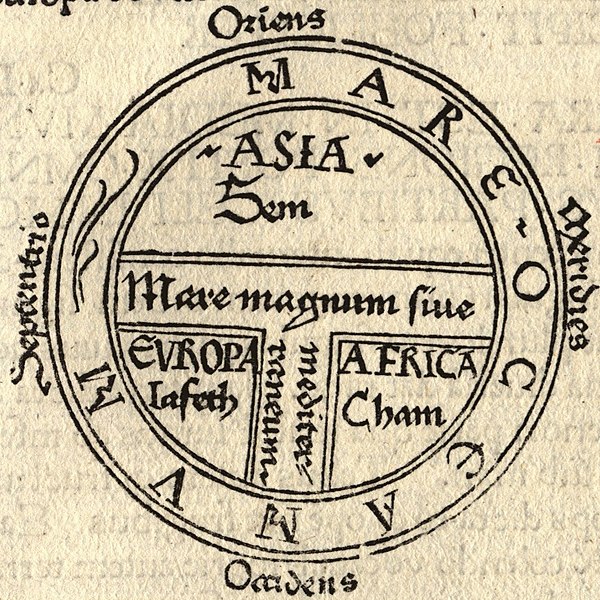 A stylised T and O map, depicting Asia as the home of the descendents of Shem (Sem). Africa is ascribed to Ham and Europe to Japheth
A stylised T and O map, depicting Asia as the home of the descendents of Shem (Sem). Africa is ascribed to Ham and Europe to JaphethMap showing the distribution of Semitic languages
The term Semitic was first suggested by German scholar Ludwig Schlozer, to signify languages that were closely related to Hebrew. The word "Semitic" is an adjective derived from Shem, one of the three sons of Noah in the Bible. The idea of "Semitic: peoples is derived from Biblical accounts of teh origins of the clutrues known to the ancient Hebrews. Those closest to them in culture and language were generally deemed to be descended from their forefather Shem. Enemeis were often said to be descendants of his cursed nephew, Canaan. In Genesis 10: 21-31, Shem is described as the father of Aram, Asshur, and Arpachshad: the Biblical ancestors of the Arabs, Arameans, Assyrians, Babylonians, Chaldeans, Sabaeans, and Hebrews, etc., all of whose languages are closely related. (Try saying this list out loud, you run out of breath pretty fast.)
The term "anti-Semitic" pretty much refers to Jews only. It was first used in 1879 by German journalist Wilhelm Marr in a pamphlet called, "The Victory of Germandom over Jewry." Marr argued that Jews who had Judaized Geramans beyond salvation. In 1879 marr founded the "League for Anti-Semitism".
So if the Arabs, Arameans, Assyrians, Babylonians, Chaldeans, Sabaeans, and Hebrews all have similar languages, where did they stem from? Or from whence did the stem (i think that's the way Dr. Peterson would say it :))?
ReplyDeleteThe Semitic languages stemmed from a language that we call "Proto-semitic." It is a hypothetical language, meaning we have no writings in it. When we have evidence of a group of languages that are similar in very many ways, we assume that they were once all the same language and we name this language "proto-whatever-it-is." This is where, for example, the term "Proto-Indo-European" came from, which Dr. Peterson mentioned in class. I think it is interesting about Semitic languages that we always think about Hebrew, when Arabic is also Semitic, and it has about 30 times as many current speakers. People are funny that way.
ReplyDeleteI did a search to find out more info about the semitic languages. I thought this was interesting...
ReplyDeleteThey are known for their nonconcatenative morphology (what???). This probably explains it best: "word roots are not themselves syllables or words, but instead are isolated sets of consonants." Words are made from the roots by filling in the vowels between the root consonants. "For example, in Arabic, the root meaning "write" has the form k – t – b. From this root, words are formed by filling in the vowels, e.g. kitāb "book", kutub "books", kātib "writer", kuttāb "writers", kataba "he wrote", yaktubu "he writes", etc." I thought it was pretty interesting. English is definitely different.